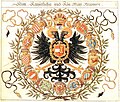Plik:Wappen röm.kaiser.JPG

Rozmiar podglądu – 707 × 599 pikseli. Inne rozdzielczości: 283 × 240 pikseli | 566 × 480 pikseli | 920 × 780 pikseli.
Rozmiar pierwotny (920 × 780 pikseli, rozmiar pliku: 279 KB, typ MIME: image/jpeg)
Historia pliku
Kliknij na datę/czas, aby zobaczyć, jak plik wyglądał w tym czasie.
| Data i czas | Miniatura | Wymiary | Użytkownik | Opis | |
|---|---|---|---|---|---|
| aktualny | 23:18, 14 paź 2005 |  | 920 × 780 (279 KB) | Finanzer | * Technisch nachbearbeitet von wolpertinger |
| 22:38, 31 sie 2005 |  | 998 × 846 (171 KB) | Fb78 | '''Description''' Wappen der Kaiser des Heiligen Römischen Reiches Deutscher Nation '''Source:''' Wappenbuch von Johann Siebmacher, 1605 Uploaded by de:Benutzer:Hansele |
Lokalne wykorzystanie pliku
Poniższa strona korzysta z tego pliku:
Globalne wykorzystanie pliku
Ten plik jest wykorzystywany także w innych projektach wiki:
- Wykorzystanie na an.wikipedia.org
- Wykorzystanie na ar.wikipedia.org
- ليوبولد الثاني (إمبراطور روماني مقدس)
- هابسبورغ
- فرديناند الأول (إمبراطور روماني مقدس)
- فيتلسباخ
- بالاتينات الانتخابية
- ألكسندر براون
- دوقية براونشفايغ لونيبورغ
- اتحاد شمالكالدي
- اجتماع شباير الثاني
- دوقية لورين
- أرنولف الكارينثي
- إمارة بايرويت
- إمارة أنسباخ
- لاندغريفية هسن دارمشتات
- ساكس فايمار
- دوقية ساكسونيا هيلدبورغهاوزن
- دوقية ساكسونيا غوتا ألتنبورغ
- دوقية ساكسونيا كوبورغ زالفلد
- دوقية أولدنبورغ
- انتخابية هسن
- لورين المنخفضة
- الأقاليم السبعة عشر
- خيلدرز
- بوابة:الإمبراطورية النمساوية/مقالة مختارة
- بوابة:الإمبراطورية النمساوية/مقالة مختارة/2
- بوابة:الإمبراطورية النمساوية
- بوابة:الإمبراطورية النمساوية/مقالة مختارة/أرشيف
- ليوبولد موتسارت
- موريتس بالتازار بوركهاوزن
- كونتية أرتوا
- الأراضي المنخفضة النمساوية
- فريدريش ألبرخت أنطون ماير
- يوري فيغا
- غابرييل غروبر
- ألبرت الرابع، دوق النمسا
- الأرشيدوقة ماريا آنا من النمسا (1610-1665)
- فيلهلم فريديمان باخ
- البرلمان الامبراطوري
- ليوبولد الرابع دوق النمسا
- يوهان كاسبار فون ستاديون
- معاهدة جيرستنجن
- سلام نيكولسبورغ
- معاهدة السلام في جميع أنحاء العالم المسيحي
- دوقية بوهيميا
- رودولف الثاني كونت هابسبورغ
- ألبرخت الرابع كونت هابسبورغ
- قالب:بذرة أعلام الإمبراطورية الرومانية المقدسة
- قالب:بذرة طبيب روماني مقدس
- قالب:بذرة كيميائي روماني مقدس
Pokaż listę globalnego wykorzystania tego pliku.

